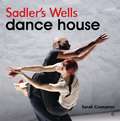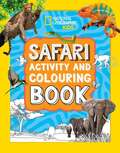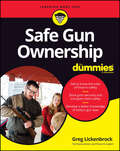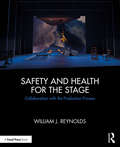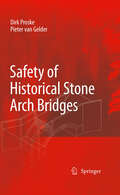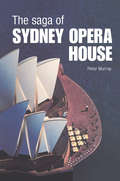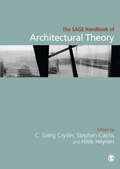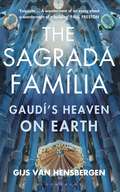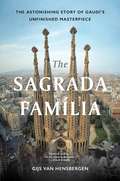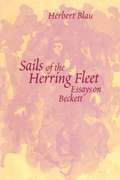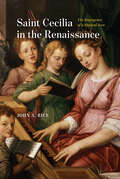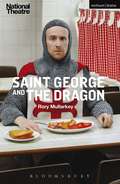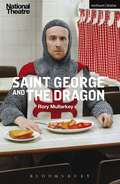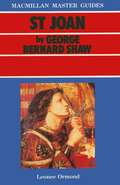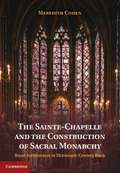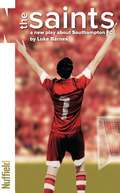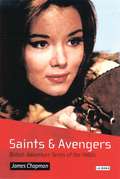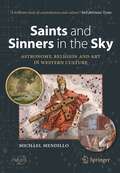- Table View
- List View
Sadler's Wells - Dance House: Dance House
by Sarah CromptonSadler’s Wells is a powerhouse, an engine room, of dance. It welcomes the best dance companies from Britain and around the world. But its significance is that it commissions the best choreographers, designers, musicians and artists to create new and exciting dance. In words and pictures this book celebrates that inspirational process. Based on interviews with artists including Matthew Bourne, Sylvie Guillem, Akram Khan, Russell Maliphant, Wayne McGregor and Hofesh Shechter, Sadler’s Wells Dance House discovers how this theatre and its creative impulses have shaped the course of dance in the twenty-first century. From classical to hip hop, from the popular successes to the divisive controversies, Sadler’s Wells Dance House tells the story of a theatre that is an international creative hub for all the best of dance today.
Safe Gun Ownership For Dummies
by Greg LickenbrockA straightforward guide to being smart with your firearm With gun sales at an all-time high in the U.S., easy-to-understand advice on storing and possessing guns safely is at an all-time premium. Safe Gun Ownership For Dummies paves the way for new and novice gun owners to learn the basics of firearm ownership in a non-partisan tone. This book helps gun owners thoroughly explore the rules of gun safety and adopt the habits of savvy firearm aficionados. Written by a firearms expert and analyst who has reviewed hundreds of firearms along with gun safety and storage options, this guide helps you develop a safety mindset and apply practices to assure you and your family avoid harm. Learn, internalize, and apply the rules of gun safety Understand federal, state, and local gun laws Find a good gun safety course for hands-on practice Store and transport your firearm securelyWhen it&’s time to start training on your new firearm and the safety rules of gun ownership, Safe Gun Ownership For Dummies is at the ready with everything you need to know to make safety your aim.
Safe Gun Ownership For Dummies
by Greg LickenbrockA straightforward guide to being smart with your firearm With gun sales at an all-time high in the U.S., easy-to-understand advice on storing and possessing guns safely is at an all-time premium. Safe Gun Ownership For Dummies paves the way for new and novice gun owners to learn the basics of firearm ownership in a non-partisan tone. This book helps gun owners thoroughly explore the rules of gun safety and adopt the habits of savvy firearm aficionados. Written by a firearms expert and analyst who has reviewed hundreds of firearms along with gun safety and storage options, this guide helps you develop a safety mindset and apply practices to assure you and your family avoid harm. Learn, internalize, and apply the rules of gun safety Understand federal, state, and local gun laws Find a good gun safety course for hands-on practice Store and transport your firearm securelyWhen it’s time to start training on your new firearm and the safety rules of gun ownership, Safe Gun Ownership For Dummies is at the ready with everything you need to know to make safety your aim.
Safeguarding Intangible Cultural Heritage: A Practical Interpretation of the 2003 UNESCO Convention (Elgar International Law and Practice series)
by Janet BlakeThis book presents a detailed analysis of the different approaches and measures for implementing the requirements of UNESCO’s 2003 Convention on Safeguarding Intangible Cultural Heritage (the Convention) and a practical interpretation of that treaty, based on the experience of States’ Parties and other primary actors. The book considers the interests of multiple stakeholders and takes account of how the Convention interacts with other international law regimes pertaining to both human rights and sustainable development.Key Features:Provides clear and concise information of the definition, scope and significance of intangible cultural heritageUtilises a wide-range of case studies to illustrate the application of the Convention on the ground.Considers the position of multiple stakeholders including national heritage organisations and non-state actorsOutlines practical strategies and solutions for protecting and promoting cultural heritage and looks ahead to potential future developments in this field.Easy to follow structure, mapping out the treaty’s provisions thematically and highlighting their practical applicationProviding accessible and focused analysis, this book will be essential reading for lawyers and practitioners involved in the protection of intangible cultural heritage from both governmental and non-governmental institutions. The book will also be a valuable resource to academics and researchers working across various disciplines including law, heritage, and anthropology.
Safety and Health for the Stage: Collaboration with the Production Process
by William J. ReynoldsSafety and Health for the Stage: Collaboration with the Production Process is a practical guide to integrating safety and health into the production process for live entertainment in the context of compliance with applicable codes, standards, and recommended practices. This book explores the need for safety and health to become an integral aspect of theatre production and live entertainment, focusing on specific steps to take and policies to employ to bring a safety and health program into full collaboration in the production process. Readers will learn how to comply with legal codes and standards as they initiate and implement an effective safety and health program in their theatre production organization or academic theatre department. The book includes references and links to other industry-specific safety and health resources, as well as a Glossary of Safety and Health Terms to navigate the safety and health jargon in the context of theatre and live entertainment. Safety and Health for the Stage: Collaboration with the Production Process provides links to electronic versions of sample safety and health programs, industry-specific policies and recommended practices, and forms and templates related to many of the topics covered in the book. Written for practitioners who are engaged in all aspects of theatre production and live entertainment, as well as educators who train and influence the next generations of these practitioners, this book is an essential resource for creating a positive culture of safety in live entertainment.
Safety and Health for the Stage: Collaboration with the Production Process
by William J. ReynoldsSafety and Health for the Stage: Collaboration with the Production Process is a practical guide to integrating safety and health into the production process for live entertainment in the context of compliance with applicable codes, standards, and recommended practices. This book explores the need for safety and health to become an integral aspect of theatre production and live entertainment, focusing on specific steps to take and policies to employ to bring a safety and health program into full collaboration in the production process. Readers will learn how to comply with legal codes and standards as they initiate and implement an effective safety and health program in their theatre production organization or academic theatre department. The book includes references and links to other industry-specific safety and health resources, as well as a Glossary of Safety and Health Terms to navigate the safety and health jargon in the context of theatre and live entertainment. Safety and Health for the Stage: Collaboration with the Production Process provides links to electronic versions of sample safety and health programs, industry-specific policies and recommended practices, and forms and templates related to many of the topics covered in the book. Written for practitioners who are engaged in all aspects of theatre production and live entertainment, as well as educators who train and influence the next generations of these practitioners, this book is an essential resource for creating a positive culture of safety in live entertainment.
Safety of historical stone arch bridges
by Dirk Proske Pieter van GelderHistorical stone arch bridges are still a major part of the infrastructure in many countries. Although this type of bridge has proven to be an efficient construction type, it often poses the problem of insufficient numerical models of the load bearing behavior. Therefore the book introduces methods to adapt life loads and introduces different types of numerical models of the load resistance respectively. The book continues with the introduction of specific damages and strengthening techniques. The book particularly focuses on the probabilistic safety assessment of historical arch bridges, for which often only limited material and structural data is available.
The Saga of Sydney Opera House: The Dramatic Story of the Design and Construction of the Icon of Modern Australia
by Peter MurrayPeter Murray's compelling and highly readable biography of the building presents both sides of the story. Using previously unpublished files and papers, Murray has managed to unravel one of the most intriguing architectural controversies of recent times - what really happened when they built Sydney Opera House...
The Saga of Sydney Opera House: The Dramatic Story of the Design and Construction of the Icon of Modern Australia
by Peter MurrayPeter Murray's compelling and highly readable biography of the building presents both sides of the story. Using previously unpublished files and papers, Murray has managed to unravel one of the most intriguing architectural controversies of recent times - what really happened when they built Sydney Opera House...
The SAGE Handbook of Architectural Theory
by Stephen Cairns Hilde Heynen Greig Crysler"Offers an intense scholarly experience in its comprehensiveness, its variety of voices and its formal organization... the editors took a risk, experimented and have delivered a much-needed resource that upends the status-quo." - Architectural Histories, journal of the European Architectural History Network "Architectural theory interweaves interdisciplinary understandings with different practices, intentions and ways of knowing. This handbook provides a lucid and comprehensive introduction to this challenging and shifting terrain, and will be of great interest to students, academics and practitioners alike." - Professor Iain Borden, UCL Bartlett School of Architecture "In this collection, architectural theory expands outward to interact with adjacent discourses such as sustainability, conservation, spatial practices, virtual technologies, and more. We have in The Handbook of Architectural Theory an example of the extreme generosity of architectural theory. It is a volume that designers and scholars of many stripes will welcome." - K. Michael Hays, Eliot Noyes Professor of Architectural Theory, Harvard University The SAGE Handbook of Architectural Theory documents and builds upon the most innovative developments in architectural theory over the last two decades. Bringing into dialogue a range of geographically, institutionally and historically competing positions, it examines and explores parallel debates in related fields. The book is divided into eight sections: Power/Difference/Embodiment Aesthetics/Pleasure/Excess Nation/World/Spectacle History/Memory/Tradition Design/Production/Practice Science/Technology/Virtuality Nature/Ecology/Sustainability City/Metropolis/Territory. Creating openings for future lines of inquiry and establishing the basis for new directions for education, research and practice, the book is organized around specific case studies to provide a critical, interpretive and speculative enquiry into the relevant debates in architectural theory.
The Sage Handbook of School Music Education
by José Luis Aróstegui Catharina Christophersen Jeananne Nichols Koji MatsunobuThe Sage Handbook of School Music Education stands as an essential guide for navigating the evolving educational landscape in the wake of the 2008 financial crisis and the transformative impact of the COVID-19 pandemic. The handbook addresses philosophical foundations, social justice challenges, the envisioning of a transformative curriculum, and critical issues in music teacher education. Written by a diverse team of leading scholars, this handbook offers a truly global perspective with contributors from Africa, Asia, Australasia, Europe, and North and South America. The handbook engages with the profound interplay of economic, political, and social forces that shape educational policies. Scholars within this collaborative work delve into what it means to educate in a world undergoing significant changes. This entails an exploration of emerging educational approaches, considerations for societal implications, and the interconnectedness of school music education with broader curricular and global contexts. As a cohesive resource, The Sage Handbook of School Music Education not only addresses the challenges faced by educators but also envisions the transformative potential of music education in fostering creativity, inclusivity, and adaptability. This handbook serves as a compass for students, practitioners and scholars in the field, and all those passionate about navigating the complexities of redefining music education for a new era. Part 1: Foundations Part 2: Struggling for Social Justice Through Music Education Part 3: Curriculum Development Part 4: Teacher Education
The Sage Handbook of School Music Education
by José Luis Aróstegui Catharina Christophersen Jeananne Nichols Koji MatsunobuThe Sage Handbook of School Music Education stands as an essential guide for navigating the evolving educational landscape in the wake of the 2008 financial crisis and the transformative impact of the COVID-19 pandemic. The handbook addresses philosophical foundations, social justice challenges, the envisioning of a transformative curriculum, and critical issues in music teacher education. Written by a diverse team of leading scholars, this handbook offers a truly global perspective with contributors from Africa, Asia, Australasia, Europe, and North and South America. The handbook engages with the profound interplay of economic, political, and social forces that shape educational policies. Scholars within this collaborative work delve into what it means to educate in a world undergoing significant changes. This entails an exploration of emerging educational approaches, considerations for societal implications, and the interconnectedness of school music education with broader curricular and global contexts. As a cohesive resource, The Sage Handbook of School Music Education not only addresses the challenges faced by educators but also envisions the transformative potential of music education in fostering creativity, inclusivity, and adaptability. This handbook serves as a compass for students, practitioners and scholars in the field, and all those passionate about navigating the complexities of redefining music education for a new era. Part 1: Foundations Part 2: Struggling for Social Justice Through Music Education Part 3: Curriculum Development Part 4: Teacher Education
The Sage Handbook of School Music Education
The Sage Handbook of School Music Education stands as an essential guide for navigating the evolving educational landscape in the wake of the 2008 financial crisis and the transformative impact of the COVID-19 pandemic. The handbook addresses philosophical foundations, social justice challenges, the envisioning of a transformative curriculum, and critical issues in music teacher education. Written by a diverse team of leading scholars, this handbook offers a truly global perspective with contributors from Africa, Asia, Australasia, Europe, and North and South America. The handbook engages with the profound interplay of economic, political, and social forces that shape educational policies. Scholars within this collaborative work delve into what it means to educate in a world undergoing significant changes. This entails an exploration of emerging educational approaches, considerations for societal implications, and the interconnectedness of school music education with broader curricular and global contexts. As a cohesive resource, The Sage Handbook of School Music Education not only addresses the challenges faced by educators but also envisions the transformative potential of music education in fostering creativity, inclusivity, and adaptability. This handbook serves as a compass for students, practitioners and scholars in the field, and all those passionate about navigating the complexities of redefining music education for a new era. Part 1: Foundations Part 2: Struggling for Social Justice Through Music Education Part 3: Curriculum Development Part 4: Teacher Education
The Sagrada Familia: Gaudí's Heaven on Earth
by Gijs Van HensbergenA definitive and illuminating biography of one of the most famous – and most famously unfinished – buildings in the world, the Sagrada Familia of Barcelona. Its scaffolding-cloaked spires reach up to the heavens, dominating the Barcelona skyline and drawing in millions of visitors every year. What seduces our attention is perhaps a combination: not only its almost megalomaniac ambition and architectural extravagance but the sheer longevity of its construction. Its creator, Antoni Gaudí, 'God's Architect', saw the first stone laid on 19 March 1882 and yet it is unlikely to be completed until 2026 at the very earliest. It has survived two World Wars, the ravages of the Spanish Civil War and the 'Hunger Years' of Franco's rule. It has defied the critics, the penny-pinching accountants, the conservative town-planners and the slaves to sterile modernism to witness the most momentous changes in society and history. The Sagrada Familia explores the evolution of this remarkable building, working through the decades right up to the present day before looking beyond to the final stretch of its construction. It is at once a guidebook and a chronological history, and a moving and compelling study of man's aspiration towards the divine. Rich in detail, vast in scope, this is a revelatory and authoritative study of a building and its place in history and the genius that created it.
The Sagrada Familia: The Astonishing Story of Gaudí’s Unfinished Masterpiece
by Gijs Van HensbergenAn illuminating biography of one of the most famous--and most famously unfinished--buildings in the world, the Sagrada Familia of Barcelona.The scaffolding-cloaked spires of Antoni Gaudí's masterpiece, the Sagrada Familia, dominate the Barcelona skyline and draw in millions of visitors every year. More than a century after the first stone was laid in 1882, the Sagrada Familia remains unfinished, a testament to Gaudí's quixotic ambition, his religious devotion, and the sensuous eccentricity of his design. It has defied the critics, the penny-pinching accountants, the conservative town-planners, and the devotees of sterile modernism. It has enchanted and frustrated the citizens of Barcelona. And it has passed through the landmark changes of twentieth-century Spain, surviving two World Wars, the ravages of the Spanish Civil War, and the "Hunger Years" of Franco's rule.Gijs van Hensbergen's The Sagrada Familia explores the evolution of this remarkable building, working through the decades right up to the present day before looking beyond to the final stretch of its construction. Rich in detail and vast in scope, this is a revelatory chronicle of an iconic structure, its place in history, and the wild genius that created it.
Sails of the Herring Fleet: Essays on Beckett (Theater: Theory/Text/Performance)
by Herbert BlauSails of the Herring Fleet traces esteemed director and theorist Herbert Blau's encounters with the work of Samuel Beckett. Blau directed Beckett's plays when they were still virtually unknown, and for more than four decades has remained one of the leading interpreters of his work. In addition to now-classic essays, the collection includes early program notes and two remarkable interviews -- one from Blau's experience directing Waiting for Godot at San Quentin prison, and one from his last visit with Beckett, just before the playwright's death. Herbert Blau is Byron W. and Alice L. Lockwood Professor of the Humanities, University of Washington.
Saint Cecilia in the Renaissance: The Emergence of a Musical Icon
by John A. RiceThis study uncovers how Saint Cecilia came to be closely associated with music and musicians. Until the fifteenth century, Saint Cecilia was not connected with music. She was perceived as one of many virgin martyrs, with no obvious musical skills or interests. During the next two centuries, however, she inspired many musical works written in her honor and a vast number of paintings that depicted her singing or playing an instrument. In this book, John A. Rice argues that Cecilia’s association with music came about in several stages, involving Christian liturgy, visual arts, and music. It was fostered by interactions between artists, musicians, and their patrons and the transfer of visual and musical traditions from northern Europe to Italy. Saint Cecilia in the Renaissance explores the cult of the saint in Medieval times and through the sixteenth century when musicians’ guilds in the Low Countries and France first chose Cecilia as their patron. The book then turns to music and the explosion of polyphonic vocal works written in Cecilia’s honor by some of the most celebrated composers in Europe. Finally, the book examines the wealth of visual representations of Cecilia especially during the Italian Renaissance, among which Raphael’s 1515 painting, The Ecstasy of Saint Cecilia, is but the most famous example. Thoroughly researched and beautifully illustrated in color, Saint Cecilia in the Renaissance is the definitive portrait of Saint Cecilia as a figure of musical and artistic inspiration.
Saint George and the Dragon (Modern Plays)
by Rory MullarkeyA village. A dragon. A damsel in distress.Into the story walks George: wandering knight, freedom fighter, enemy of tyrants the world over. One epic battle later and a nation is born.As the village grows into a town, and the town into a city, the myth of Saint George which once brought a people together, threatens to divide them.
Saint George and the Dragon (Modern Plays)
by Rory MullarkeyA village. A dragon. A damsel in distress.Into the story walks George: wandering knight, freedom fighter, enemy of tyrants the world over. One epic battle later and a nation is born.As the village grows into a town, and the town into a city, the myth of Saint George which once brought a people together, threatens to divide them.
The Sainte-chapelle And The Construction Of Sacral Monarchy: Royal Architecture In Thirteenth-century Paris (PDF)
by Meredith CohenThis book offers a novel perspective on one of the most important monuments of French Gothic architecture, the Sainte-Chapelle, constructed in Paris by King Louis IX of France between 1239 and 1248 especially to hold and to celebrate Christ's Crown of Thorns. Meredith Cohen argues that the chapel's architecture, decoration, and use conveyed the notion of sacral kingship to its audience in Paris and in greater Europe, thereby implicitly elevating the French king to the level of suzerain, and establishing an early visual precedent for the political theories of royal sovereignty and French absolutism. By setting the chapel within its broader urban and royal contexts, this book offers new insight into royal representation and the rise of Paris as a political and cultural capital in the thirteenth century.
The Saints (Oberon Modern Plays)
by Luke Barnes‘I’m looking at you– you’re about to find God in here, on the pitch, in the stands, on the grass, this is a holy day for you. For all of us. This is how we touch Heaven. By being here. Being God for The Saints. We make this holy.’ Kenny Glynn is the world’s biggest Saints fan and for twenty-five years he has been locked in a game of football against the world. On his 29th birthday the world steps up its game and Kenny Glynn faces the match of his life as he takes on women, money and status with the help of his mates, his family and the guiding spirit of Matt Le Tissier. Can they conquer all the things the world is throwing at them? Will Southampton ever win the FA cup again? And what can we learn from the icons we hold so dearly at the club?
Saints and Avengers: British Adventure Series of the 1960s (Popular Television Genres)
by James ChapmanDuring the 1960s, a new genre hit the television screens: the secret agent/detective thriller. Largely produced by British independent television companies, these series were sold to the US and elsewhere, marking the breakthrough of British television into the world market place. Today they are still shown on cable and terrestrial TV. Eccentric, ironic and fantastic, series like The Avengers and Danger Man, with their professional secret agents, or The Saint and The Persuaders, featuring flamboyant crime-fighters, still inspire mainstream and cult followings.Saints and Avengers explores and celebrates this unique television genre for the first time. James Chapman is a past-master at taking popular culture seriously, while also enjoying its productions in their own right. He uses case studies to look, for example, at the thrillers' representations of national identity and of masculinity and their negotiation of the social and cultural changes in the world of the sixties and seventies. He also proves his central thesis: that this particular type of thriller was a historically and culturally defined generic type, with enduring appeal, as the current vogue for remaking them as big budget films attests.
Saints and Sinners in the Sky: Astronomy, Religion and Art in Western Culture (Springer Praxis Books)
by Michael Mendillo"A brilliant study of constellations and culture." - Neil deGrasse TysonIn this book, Boston University Professor of Astronomy Michael Mendillo takes readers deep into the annals of history, showing how visual depictions of the heavens evolved in tandem with science and religion throughout much of Western culture. With unprecedented scope and scale, Professor Mendillo explores how cave art, illuminated manuscripts, sculptures, paintings and architecture reflected some of the great religious and secular battles taking place over the course of centuries. Enter a world of biblical proportions, where constellations of ancient heroes and pagans were thoroughly recast as Christian saints and the Twelve Apostles. This nontechnical narrative brings vitality and accessibility to some of the most enduring subjects in human history, offering a lively new exploration of the visual connections between celestial phenomena and artistic expression."Saints and Sinners impressionistically reveals the connections of art, astronomy, and religion in Western culture to illuminate the age-old quest for celestial-terrestrial connections.” - Roberta J.M. Olson, author of Giotto’s Portrait of Halley’s Comet and Cosmos: The Art and Science of the Universe “Professor Mendillo’s book does a priceless service, opening the doors of our minds to images that will stir us, because the heavens are part of us, and we all long to know how and why.” - Rev. David R. Thom, MIT Chaplain and Convener of the Cambridge Faculty Roundtable on Science, Art & Religion "Over a lifetime devoted to astronomical research and teaching, Michael Mendillo has indulged a parallel passion for artistic representations of the heavenly bodies. In this sumptuous volume, he explores the projection of our changing belief systems onto the constant stars.” - Dava Sobel, author of Longitude, Galileo’s Daughter and The Glass Universe
